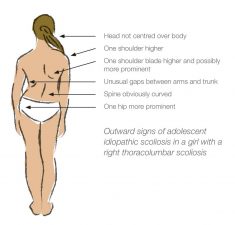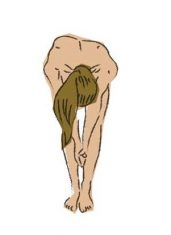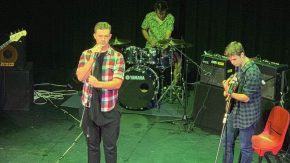From the Nurse
Scoliosis
Scoliosis is the name given to a condition that causes the spine to curve sideways.
Cause
In most cases, the cause is unknown or idiopathic but there may be a family history of scoliosis.
Some rarer forms of scoliosis may be present from birth and some are caused by conditions affecting the muscles and nerves, such as cerebral palsy.
One known cause is uneven leg length causing the hips to tilt and the shoulders curve the opposite way to compensate.
Poor posture, a soft mattress or carrying heavy backpacks does not cause scoliosis.
Signs and symptoms
Idiopathic Scoliosis (unknown cause) is more likely to occur during a growth spurt between the ages 10-18 years.
- One shoulder tilted down towards a raised hip
- Protruding shoulder blade on one side
- Uneven waistline
- Ribs more prominent on one side
- The head is slightly tilted
Most cases are mild and the person experiences no symptoms and requires no medical treatment. If the scoliosis is more severe and the curve worsens as years go by symptoms of back pain, breathing difficulties if the rib cage is compressed, problems with pregnancy and physical disability can occur later in life.
Tests
The Forward Bending Test is a simple way to check for Idiopathic Scoliosis.
The recommended age for testing boys is 14 years and girls 10-12 years.
- Stand with feet together and parallel.
- Place palms of hands together with arms straight.
- Bend forward towards feet with fingertips pointing between the big toes.
Here the right upper back is more prominent and requires further assessment.
The GP will order an X-ray and the angles of the curve are measured. Regular medical checks and X-rays are done to see if the curve is worsening. A referral to a Spine Specialist would be organised if needed.
Treatment in adolescents
Scoliosis, which requires treatment, is far less common in boys than in girls. In fact 90% of patients in scoliosis clinics are adolescent girls.
Minor curves of < 25 degrees are not treated and are observed usually at four month intervals.
For those curves greater than this, particularly if they start to increase during a growth spurt, a brace is fitted and worn often for 23 hours a day, for 12-18 months. Braces help control a curve but cannot cure scoliosis. Teens can be worried about body image, self-esteem and teasing from others. They need lots of support, along with good education about their condition to help them manage.
For severe cases surgery may be recommended (one per thousand cases). This involves internal fixation of the spine to correct the curve.
Sister Margaret Bates
School Nurse
References








